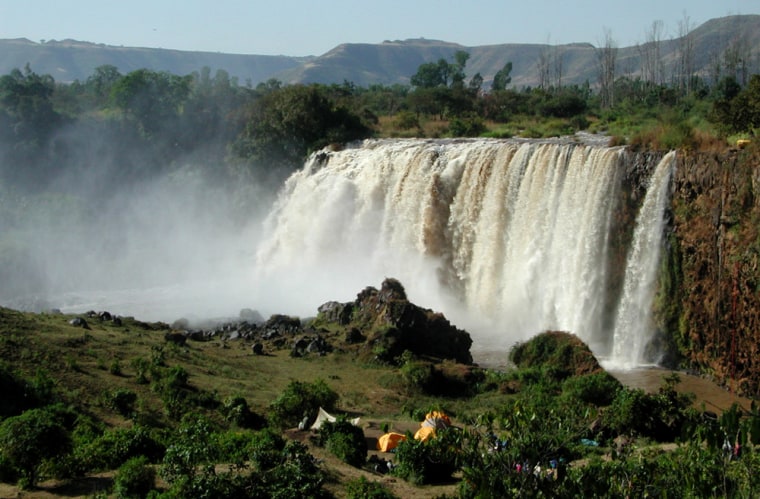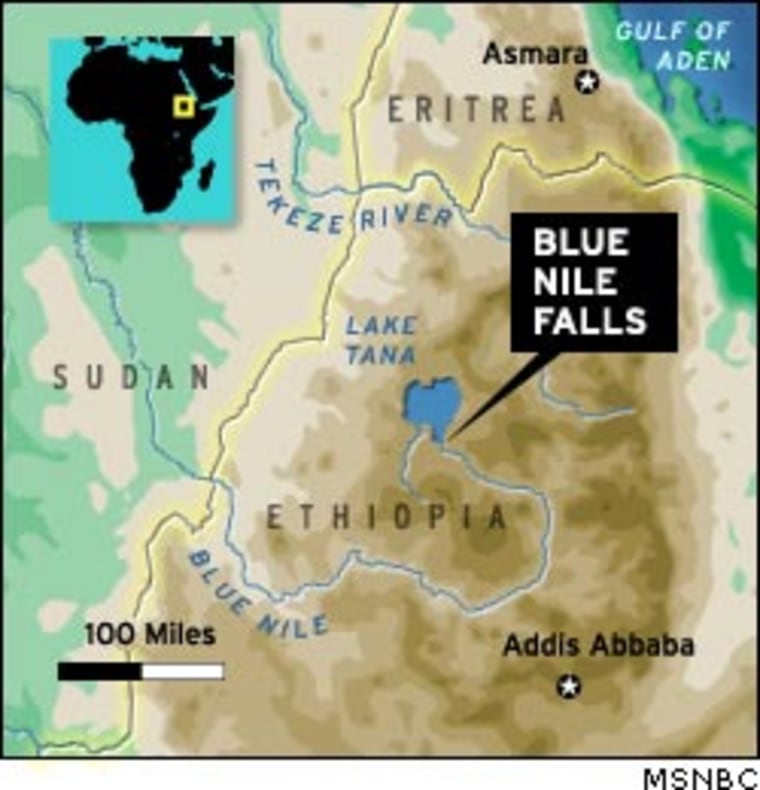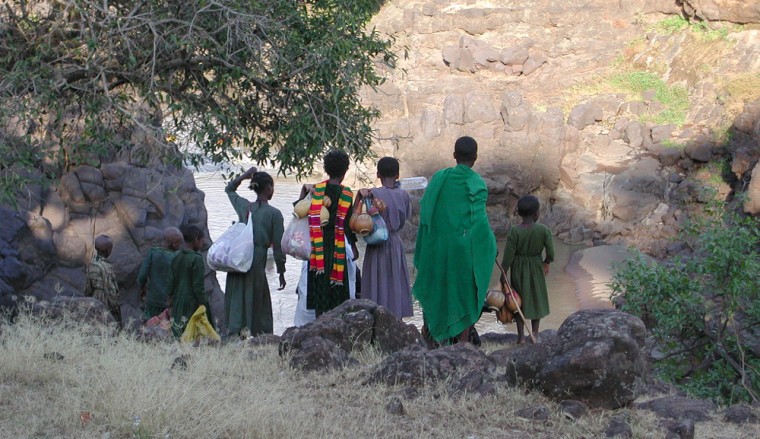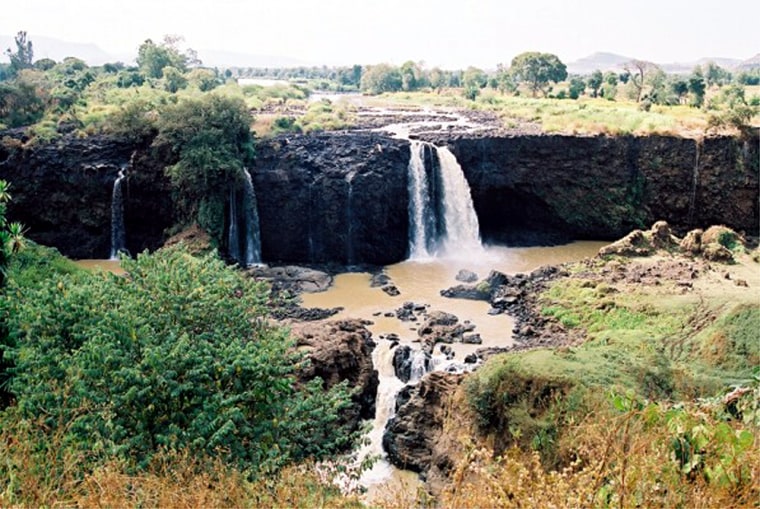The Blue Nile brought me to Africa in 1973. To locate its source -- Quaerere caput Nili -- had been the hope of many great captains and geographers of the classical age: Herodotus, Cyrus and Cambyses of Persia, Alexander the Great, Julius Caesar, Nero. The first Briton to make his way to the source, perhaps in search of the Ark of Covenant, was the Scot James Bruce. I had been enthralled by the writings of Bruce and of Alan Moorehead, whose book "The Blue Nile" swept me into a world beyond the pages of "National Geographic". I started a correspondence with Moorehead, who lived in Switzerland in the late 1960s, and before he died he sent me a note urging me to travel to Ethiopia to see firsthand the stories he had told.
So, in 1973 I made my way to the Ethiopian highlands and the Blue Nile, and found myself standing on a mist-swept palisade transfixed by the 150-foot-high Tissisat Falls (smoke of fire), more popularly known as the Blue Nile Falls. They were the most glorious display of falling water I had ever seen.
James Bruce, in his search for the source of the Nile, came upon the falls in 1770 and described it thusly: “The river ... fell in one sheet of water, without any interval, above half an English mile in breadth, with a force and a noise that was truly terrible, and which stunned and made me, for a time, perfectly dizzy. A thick fume, or haze, covered the fall all around, and hung over the course of the stream both above and below, marking its track, though the water was not seen. ... It was a most magnificent sight, that ages, added to the greatest length of human life, would not deface or eradicate from my memory.”

When I first stood before the immense manitou of the Blue Nile Falls, watching the water spout and bloom like gargantuan brown mushrooms and the mist shape and move like a timelapse sequence of clouds, I was struck by how accurate Bruce had been and how little the sight had changed in more than 200 years. The other great waterfalls of the world -- Niagara, Iguazu, Victoria --are all now pocked with hotels and tourist boutiques and scenic flights. At the Blue Nile Falls, however, there was nothing save the raw, deep voice of nature and an architecture supported by the brilliant beams of rainbows. I had no reason to consider they might ever change.
Return for IMAX film
My return to The Blue Nile this year was pulled into motion with a call from MacGillivray Freeman Films, the IMAX film producer of "To Fly," "Everest" and others. The company was co-producing a new IMAX entitled, "Mystery of the Nile". The concept of the film was tracing the waters that slake and fertilize Egypt from the headwaters of the Blue Nile in Ethiopia, through the Sudan, across Egypt and into the Mediterranean at Alexandria. While the White Nile is the longer of the two streams that join in Khartoum to create the Nile proper, it is the Blue Nile that contributes about 85 percent of the water that powers Egypt, and most of the precious silt that nourishes its banks. If the Blue Nile dried up, or was dammed or diverted in a significant way, Egypt would die.

The IMAX film planned on featuring several key scenes at the Blue Nile Falls, the grandest cataract in the whole of the Nile system, and the producers asked if I would codirect. So, in October, during a scout for the film, I chartered a Cessna and winged up the Blue Nile towards the falls. As we wound up the brown, serpentine ribbon, I was anxious to figure out how to film the falls in the IMAX format in a way that would do them justice.
But anxiety turned to anticipation as we approached. Early October was the best time to see the falls, just after the rains, and I knew I was in for an aerial treat.
But as I gazed downwards something was wrong … the falls were but a shadow of how I remembered them … instead of a blazing curtain of water half a mile wide, only about a third of the basaltic lip hosted water. The rest, it seemed, was rolling down a giant canal to the west of the river, into a massive concrete spillway. What had happened to the great falls? The plane circled with my nose pressed against the window, stunned at the sight.
I spent the next two days meeting with local officials securing permissions for the shoot. When I finally made my way down to Tissisat it was Sunday, and the falls were as I remembered, a plunging diadem of water slinging mist into my face.
The scenes envisioned for the film included lowering rafts over the wall of the falls, rappelling down its side, and sending over a “ghost boat,” an unmanned, unrigged raft, as the British Army had done in 1968 during an attempted descent of the river. The falls were full enough to make this all happen, but I was curious as to why a few days earlier the falls seemed to be a fraction of this Sunday’s volume.
Flow diverted by hydropower project
Yohannes Assefa, our local outfitter for the project, did some digging around and said that a new $63 million, 450 megawatt power generating station called Tis Abay II was just gearing up, diverting water on weekdays, but not yet on Sundays and holidays when there was less demand for the power. This news was disturbing.
More than 90 percent of energy consumed in Ethiopia is derived from biomass fuels and is almost entirely used for cooking, and the use of these fuels has resulted in massive deforestation and soil erosion. Only 4 percent of the population has access to electricity. Yet Ethiopia, which sits atop a mile and half high plateau, has huge rivers and canyons hurtling off all sides, offering vast hydropower potential. But the only reason to compromise the Blue Nile Falls, one of the great natural wonders of the world, would be to tap into power cheaper and faster. An hour flight in any direction reveals scores of deep gorge alternatives.
I didn’t quite believe it, and when back in the United States Googled the Web and searched to see if there were any further explanations. But I could find nothing ... just a slew of travel companies offering tours to see the singularly splendid falls in the coming weeks, the traditional high season.
Fearing the worst, though, I scheduled the falls scenes for Sunday for when we returned a month later. But when we arrived mid-November, a week prior to the shoot to make final arrangements, I was shocked beyond shock. It was the Sunday before the scheduled shoot when I walked up the familiar path to the palisade overlook of the falls and saw almost nothing there. A thin ribbon of water scraped down the cheek of the dark cliff that once was a breathtaking spectacle, and an icon for the Ethiopia.
The country’s paper currency, the one birr note, proudly showcases the falls in spate; posters of the falls plaster offices and restaurants around the country. Yet the falls were gone, 90 percent diverted into this new power scheme built by Chinese and Serbian contractors. The river was redeposited a few hundred yards downstream after pouring through penstocks and turbines, but it had left the great falls bald and sallow.
Impact on locals, tourists
This seemed a crime against nature, against aesthetic sensibilities, even against local economies. The village women and children who sold calabashes, weavings, sodas, trinkets and walking sticks to tourists complained to me how their livelihood was suffering. Tana fishermen carped that the lake was being drained to keep diversion flows steady, and lower lake levels were exposing fish hatcheries, reducing the fish population.

Back at the hotel I kept running into angry Western tourists who had spent hundreds of dollars and sometimes hours of flying to witness the Blue Nile Falls at their best and now felt snookered. Tourism, which had dropped to a trickle under the radical socialist regime of Mengistu Haile Mariam in the 80s, had been coming back under the new administration of Meles Zenawi, and the Blue Nile Falls was a top draw. But no more. Before constructing the diversion dam, the Ethiopian government hired consulting firms from France and Britain for the feasibility study. The study concluded that, unlike other hydropower projects with big dams, Tis Abay II would have “negligible impact on the environment, and that it would be economically very attractive for investment.” Somehow, though, the project sailed to completion without the cognizance of any international environmental watchdog group, or any journalists. This was the first season the diversion project had been put into full effect, and the first time tourists were discovering that what they had come to see had vanished, gone with manmade legerdemain.
And it put the film in a dilemma. The conceit was more about the historical aspects of the water that flowed to and fed Egypt, though it imagined the spectacular falls and scenes of modern adventurers recreating some of what the British army had done. The film could change its concept and take an environmental stance, exposing the stealing of the falls by short-sighted, power-hungry bureaucrats. But the falls were just plain ugly in their current state, not an IMAX moment, which is a scene of preternatural beauty shown in high-definition large format. So, we devised another solution. We called the vice minister of water resources and explained our film and its purpose. And after much negotiating he agreed to close the dam for us for four hours to film the falls in full.
We spent the week filming the rapids above the falls as planed. At one point, though, our team was arrested and the boats confiscated as we floated down a 400 yard section of the river about 20 miles above the falls where the Blue Nile has yet another recent diversion, a low height weir that allows regulation of the water flow from Lake Tana, its source. A few hours after appealing to the local police commissioner, everyone and everything was released, but again we had stumbled into a little-known scheme that was altering the balance of nature.
Falls turned back on, briefly
At last, on the given day, we gathered at the falls, and watched it rise to its previous levels. It was as breathtaking as it had ever been. We filmed our scenes of rappelling, roping boats over, and pitching an empty raft down the plunge, all fantastic, but somehow tinged with melancholy, knowing it was not quite real. Some lucky tourists wandered over to the viewpoints and were delighted with the falls, not knowing what they were beholding was a scene not available in a few hours time.
A few days later we wrapped the Ethiopian portion of the film, and I boarded the Ethiopian Airlines flight back to Addis Ababa, the capital, where I would connect with an international flight home. As we took off, the pilot circled over the falls, as he had done for years to show off his country’s greatest natural asset to the tourists on board. But as he dipped his wings, and I looked straight down to the where the Nile makes its greatest plunge, there was nothing there. Just a cold, gloomy empty cliff.
The second chapter of the book of Genesis refers to the rivers that flow through the Garden of Eden: “And the name of the second river is Ghion; the same is it that compasseth the whole land of Ethiopia.” The Blue Nile, sweeping out from Lake Tana in a wide loop, does indeed encompass the ancient land of Ethiopia. Though today the fountain of this paradise is turned off, and the garden of grasses, reeds, leaves, and lush trees and plants once showered with a perpetual spray from the falls, are now brown and dry, edenic no more.
Richard Bangs co-directed "Mystery of the Nile," scheduled for release in the fall of 2005, and was recently editor-at-large for Expedia.com. He also is co-founder of Mountain Travel-Sobek, and author of 13 books. His latest is “Adventure Without End.”
